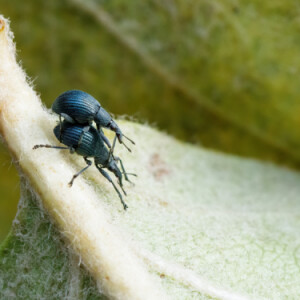Salmon-Eggs
This isn't the most appealing photo I took today - that would be the spooning Oxystoma pomonae weevils in the extra - but it's a first for me (unlike my favourite weevils), and that's enough to get it into pole position this evening.
I found these structures, which are the fruiting bodies of a slime mould called Trichia decipiens, or Salmon-Eggs, on the same pile of rotting elder logs on which I photographed the Candlesnuff Fungus last week. They weren't there then, or when I checked this log pile yesterday, but today when I walked down to this dark corner of the wild garden they stood out like a group of tiny Belisha beacons. Each globular orange sporangium is around one to one and a half millimetres in diameter, and is connected to the underlying substrate by a white stem of around the same length.
For many years Myxomycetes or slime moulds were thought to be fungi, but it was eventually determined that they had more in common with the Ameobozoans, and this is how they're now classified (though there still seems to be quite a lot of debate around the taxonomy). All slime moulds have a similar two-stage life cycle: a microscopic, amoebic phase in which they consist of separate, single-celled organisms; and a macroscopic plasmodium phase, when many of these amoebic phase cells fuse together, forming a single cell with thousands of nuclei.
The amoebic phase tends to persist where food is plentiful, the single-celled organisms living on bacteria, yeasts, fungal spores and other micro-organisms, which they engulf by phagocytosis. These organisms can both swim and creep across dry surfaces via ameboid motion, but if environmental conditions become too dry and hostile they can also encyst - that is, harden their outer membranes and become inactive, until the environment improves.
The plasmodium phase tends to occur later in the year when food is becoming scarcer. Cells of the amoebic phase signal to each other chemically, move together, and fuse to form a single-celled organism with multiple nuclei. The plasmodium grows in size by internal division of its nuclei and by continuing to attract other amoebic cells to it, and (depending on the species and the conditions) it can swell to as much as a metre in diameter. In order to search for food, or to pursue darker and more humid conditions, the plasmodium moves via cytoplasmic streaming. (This has been described as an unsettling sight - a statement that in itself unsettles me, by bringing back childhood memories of television science fiction dramas. Knowing now that I have at least one slime mould in the garden, I'll just have to trust that its cystoplasmic streaming happens more slowly than I can run.)
Some, though not all, slime moulds are also capable of forming fruiting bodies such as these, a process that usually happens towards the end of the year. Warty protrusions appear on the surface of the slime, and grow outwards into these globular sporangia, inside which spores will form. The sporangia are attached by slender stalks to what remains of the plasmodium, and over time this entire structure ripens, darkens and hardens. When the sporangia eventually burst open the spores will be carried away by the wind or by invertebrates, and if they're deposited in favourable locations they will germinate, producing a new generation of the single-celled amoebic phase organisms and thus completing the cycle.
I hope you were taking notes on all of this, because I'll be setting a test third period Friday. Good luck!


Comments
Sign in or get an account to comment.


